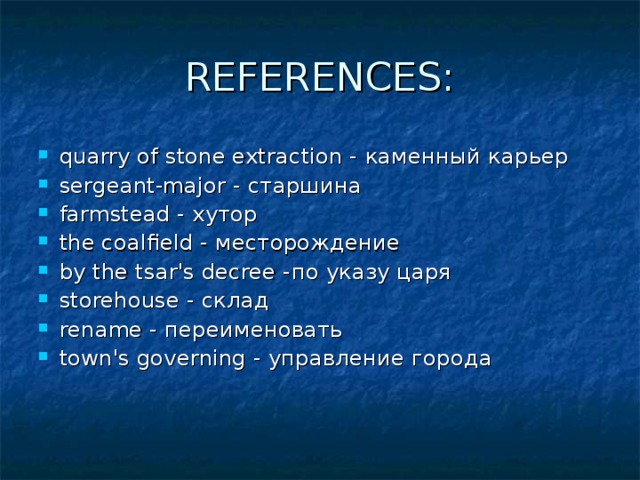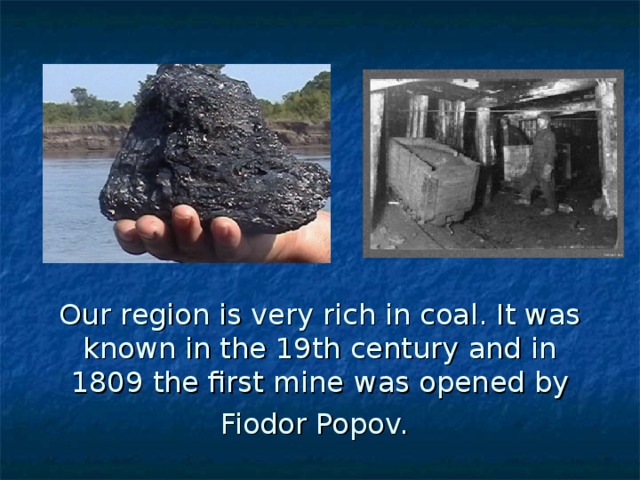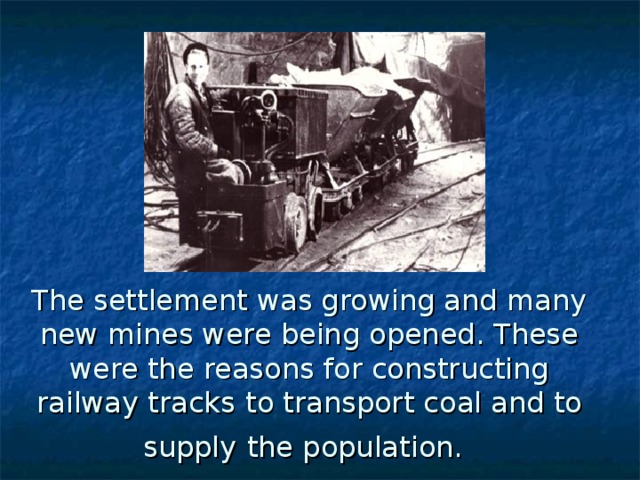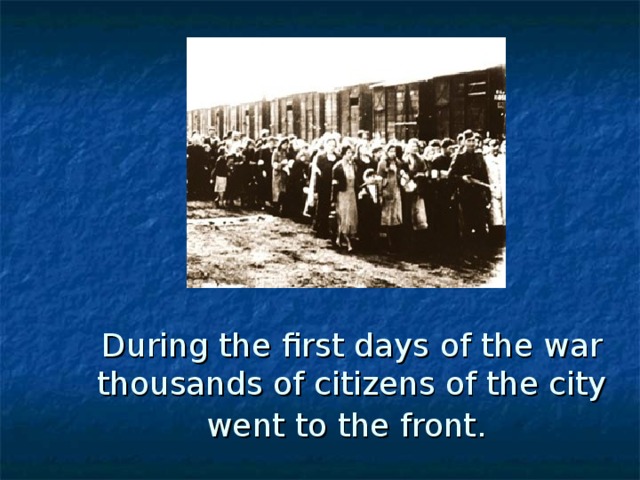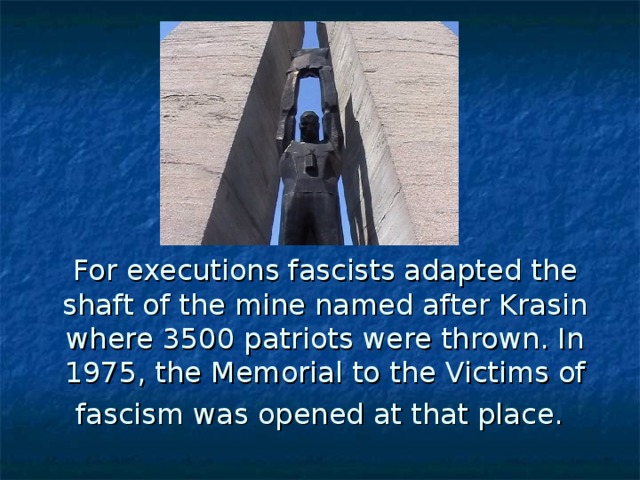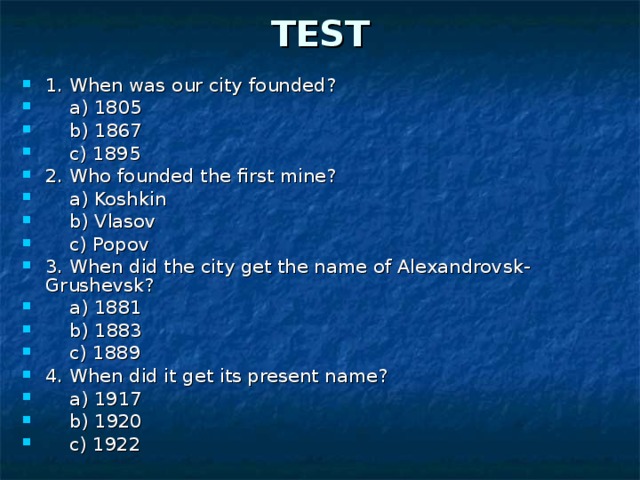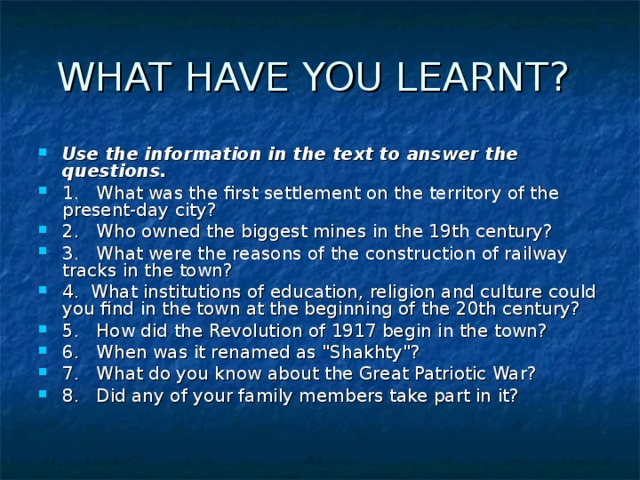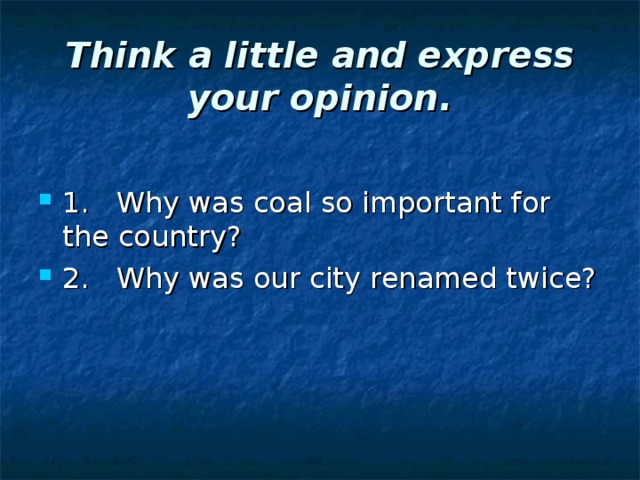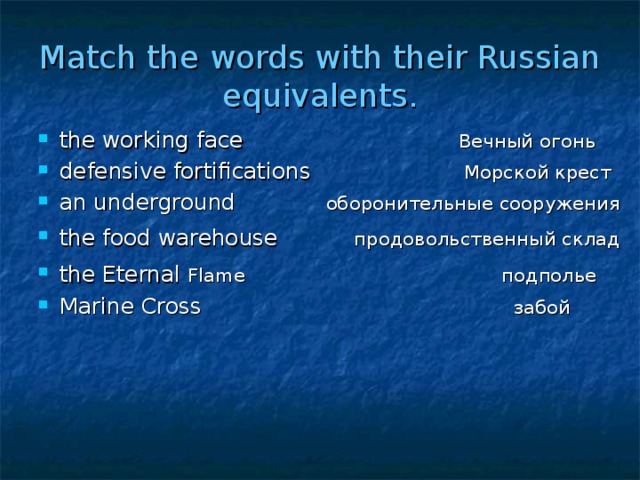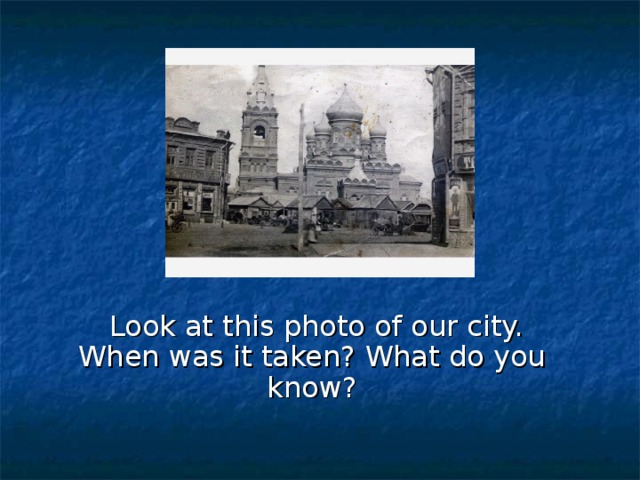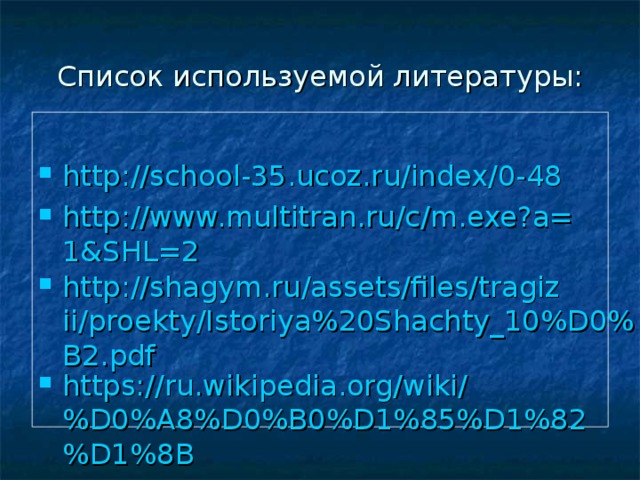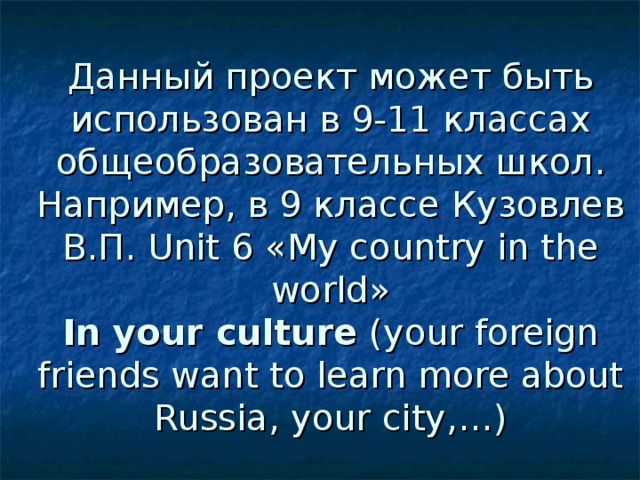Кузовлев В.П. Unit 6 9класс
«Славные страницы истории города Шахты»
Цель: развитие коммуникативных навыков учащихся в обсуждении истории их родного города
Задачи:
-познавательные - знакомство с историей своего родного города на английском языке, развитие умения представлять свою культуру;
-развивающие - развитие внимания, памяти, догадки по аналогии с русским языком, по контексту и словообразовательным элементам, синонимам; развитие способности перефразировать;
-учебные - формирование лексических навыков говорения;
-воспитательные - воспитание уважительного отношения к другим культурам; воспитание чувства гордости за свою страну, свой город
Компетенции:
- речевая: развитие коммуникативных умений говорения, аудирования, чтения;
- языковая: совершенствование навыка употребления лексики по проблеме «История города Шахты»; Совершенствование навыков грамматики ( времена группы Past);
- социокультурная - диалог культур, ознакомление с историей родного города;
- компенсаторная - совершенствование навыков языковой догадки в умении понимать из контекста;
- учебно-познавательная - умение анализировать, сравнивать, выявлять существенное, работа с ИКТ;
Содержание: материал об истории города Шахты;
Средства: проектор, экран, учебник, раздаточный материал;
Формы: различные (от фронтальной до индивидуальной);
Методы: коммуникативный метод, наглядный, проблемно- поисковый;
Технологии: развивающего обучения; сотрудничества; проектной технологии.
План урока
1 Организационный момент (приветствие, введение учащихся в проблему урока)
2 Речевая зарядка
3 Проверка домашнего задания
4 Основной этап урока (работа с презентацией):
- эпиграф (слайд 2)
- отработка новой лексики (слайд 3):
quarry of stone extraction - каменный карьер
sergeant-major - старшина
farmstead - хутор
the coalfield - месторождение
by the tsar's decree -по указу царя
storehouse - склад
rename - переименовать
town's governing - управление города
- аудирование текста с опорой на картинки (слайды 4-9):
The History of Our City
The first settlement on the territory of the present-day Shakhty was registered on the bank of the river Grushevka in 1805. It was a tiny village of several houses and one street called Korennaya. Ataman Popov was the first to found the settlement there. One of the districts of our city is unofficially named in his honour.
(слайд 4)Our region is very rich in coal. It was known in the 19th century and in 1809 the first mine was opened by Fiodor Popov. The mine was 25 meters deep and was equipped with manual rising mechanism. On the other bank of the river there was a quarry of stone extraction. The owner of that
enterprise was the seaman Captain Roman Mansurov. Stone from the quarry was used for buildings of Rostov and Novocherkassk.
Just north of it sergeant-major Vlasov founded Grushevsko Vlasovsky farmstead. Those two settlements, Popovka and Grushevsko - Vlasovsky farmstead, were the basis of our town.
Since that time mining construction began its steady development. The bigger mines were opened by Semion Koshkin in 1817 and in 1841. Mining manufacturing was gaining its importance. More and more Russian investors recognized the profit of mining business on this territory. In 1860 the coalfield of the region produced 40 percent of Russia's coal output.
(слайд 5)By the tsar's decree on October 3, 1867 Grushevskoye mining settlement was adopted. There were huts, plain houses, a church, a prison, and barracks for the Cossacks, pubs, a market, wine storehouses. The population of the town was about 3,000 people.
(слайд 6)The settlement was growing and many new mines were being opened. These were the reasons for constructing railway tracks to transport coal and to supply the population. The railway was used very intensively as the extraction had increased due to new equipment for mining and a great number of skilled workers.
In 1881 the settlement was renamed as Alexandrovsk-Grushevsk in honour of the Emperor Alexander II.
The town entered the 20th century having a library, mining vocational school, a gymnasium, church schools, a school of commerce, Peter and Paul's Cathedral and a church, hotels and cinemas.
The October Revolution of 1917 in the town began on the Paramonov's mines (Glubokaya) with the strike of the workers. It was supported by other miners, and the Soviets took town's governing in their hands. On February 11, 1920 the town was renamed again. It got the name Shakhty due to the leading industry.
In the period of 1920s - 1930s the town was growing rapidly. The electric station was built in the Artiom district. Due to mechanization of the industry the coal extraction increased greatly. Tram lines appeared. There were 30 secondary schools. The citizens saw the coming of 1941 living in the rich and prosperous town.
Our City in the Great Patriotic War
The Great Patriotic War broke out on the 22nd of June, 1941, and the life in the city changed greatly.
(слайд 7)During the first days of the war thousands of citizens of the city went to the front. Those who stayed showed the miracles of heroism and working valour. They not only fulfilled but exceeded the plan of coal mining,
introduced fast ways of mining. Women took places of their husbands and brothers in the working face.
By the spring 1942 the construction of defensive fortifications around the city had nearly been completed. Women made ninety-five per cent of all manpower.
On the 24th of July, 1942, the Soviet troops left the city. The first action of the German command was execution of active workers and captives.
(слайд 8) For executions fascists adapted the shaft of the mine named after Krasin where 3500 patriots were thrown. In 1975, the Memorial to the Victims of fascism was opened at that place. All together 13854 people were killed in the city during the period of occupation. 3500 young men and women were driven to Germany.
As well as in other cities and towns an underground was founded in Shakhty which was headed by T.S.Kholodov, I.T.Klimenko, O.A.Meshkova and others.
On the 12th of February, 1943, our city was liberated by the troops of the 5th Army of the Southern Front. After the liberation the citizens started the city-wide reconstruction of the mines,
factories, schools and hospitals. Although the number of workers was less than necessary the mining of coal was growing day after day.
(слайд 9)The Eternal Flame, the Alley of Glory, Victory Square, a lot of memorials and memorial tablets remind us of the heroism of our city-folk.
When the great day of our victory came the citizens of our city could say that they had fulfilled their duties to the country.
- выполнение тестовых заданий по прослушанному
(слайд 10) :
TEST
1. When was our city founded?
a) 1805
b) 1867
c) 1895
2. Who founded the first mine?
a) Koshkin
b) Vlasov
c) Popov
3. When did the city get the name of Alexandrovsk- Grushevsk?
a) 1881
b) 1883
c) 1889
4. When did it get its present name?
a) 1917
b) 1920
c) 1922
- учащиеся отвечают на вопросы по тексту (слайд 11):
Use the information in the text to answer the questions.
1. What was the first settlement on the territory of the present-day city?
2. Who owned the biggest mines in the 19th century?
3. What were the reasons of the construction of railway tracks in the town?
4. What institutions of education, religion and culture could you find in the town at the beginning of the 20th century?
5. How did the Revolution of 1917 begin in the town?
6. When was it renamed as "Shakhty"?
7. What do you know about the Great Patriotic War?
8. Did any of your family members take part in it?
- работа в группах (слайд 12):
Think a little and express your opinion.
- Why was coal so important for the country? ( 1 группа)
- Why was our city renamed twice?(2 группа)
- работа с лексикой (слайд 13): раздаточный материал
Match the words with their Russian equivalents.
- the working face Вечный огонь
- defensive fortifications Морской крест
- an underground оборонительные сооружения
- the food warehouse продовольственный склад
- the Eternal Flame подполье
Marine Cross забой
- работа в группах (слайд 14):
Look at this photo of our city. When was it taken? What do you know?
5 Подведение итогов урока
6 Домашнее задание: подготовить презентацию об одном из героев ВОВ нашего города


